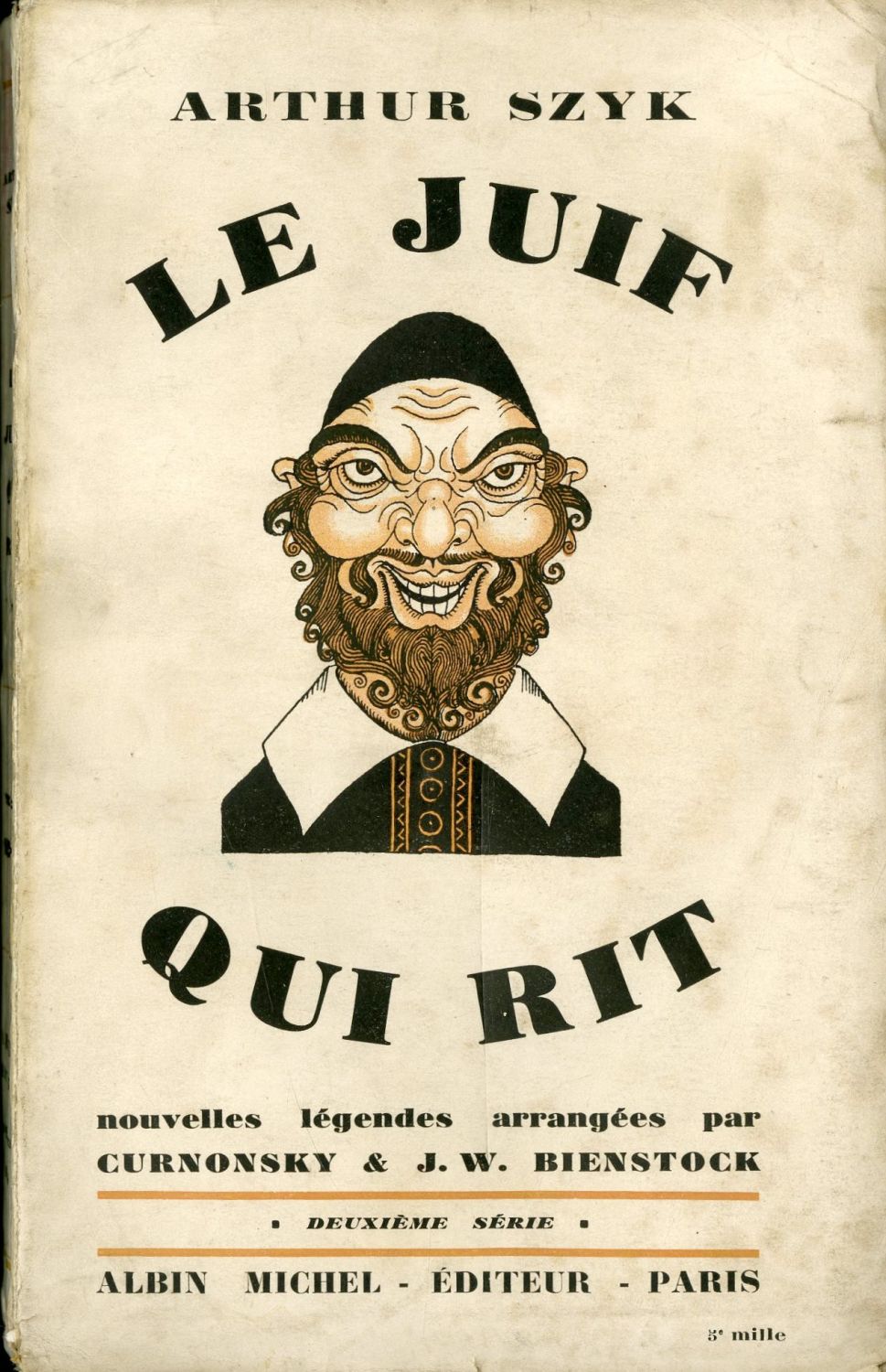
Le Juif Qui rit, Légendes Anciennes et Nouvelles [The Laughing Jew, Old and New Tales], edited by Curnonsky, & Bienstock, J-W, introduction by M. Anatole de Monzie. Paris, [1926]. French.
Humorous scenes from Jewish life in pre-war Europe divided into themes that surround Jewish life, accompanied by dozens of cartoons and humorous illustrations across each page depicted in short sentences by the artist Arthur Szyk. A rare book from the period of Szyk's early creation.
221, [1] p. 19 cm. Good - very good condition.

BEWIIS VAN VLIJT EN GOED GEDRAG - Decorated Certificate of Excellence for Good Conduct - Certificate of Excellence of the NEDRL ISRAEL GODS ARMENSCHOOL TE AMSTERDAM School, which was given to the student Mordechai Ben Yaakov (his name appears in Hebrew). Lithographic print N.H. Beer, Amsterdam 1888.
Extremely rare. Certificates of this kind given to a student who excelled most over the rest of the class are extremely rare, as the school awarded only one such certificate to a single student out of several dozen in its class. We have not found a similar example that has been preserved to this day!
Size: 22x14 cm. Tears in margins. Good condition.

An important collection of 67 membership cards for women who were members of the Fédération féminines sportives de France - many of them are Jewish women who were themselves athletes and took part in the competitions and championships held by the Federation in the various sports, or those that were members of the Federation. France, 1920s.
All cards show the passport photo of the cardholder, her personal details, and an ink stamp of the Federation of Sports Associations in France. Many 'membership cards' of Jewish women appear, such as: Anna Levy, Yehudit Levy, Nissenbaum Bracha, Andrea Grossman, Adel Cohen, Dina Blum, Birnbaum family, and others.
The Federation of Women's Sports Associations of France was an organization under which it has united the women's sports clubs in the whole of France. The first federation dedicated to women's physical activity only, appeared in 1912. The first women's athletics championships were held in 1917. Dr. Raoul Bodet and Mrs. Marie Sorkoff headed the organization from its inception. The acronyms of the federation as of 1921 included the abbreviated name FFSF of the French Women's Sports Association, as it appears in the membership cards before us.
67 membership cards. Same size: 13x8 cm. Very good condition.

An important collection of five issues of newspapers announcing the deaths of the great spiritual leaders of the Zionist revival movement. They are all historical issues that came out on the day of the death itself when the rumor came, or the day after and informed the public for the first time of their death.
* Issue of the Ha'aretz newspaper, dated, January 2, 1927, announcing the death of Ahad Ha'am' (before his burial!). headline: "The candle went out and Ahad Ha'am died this morning at six o'clock. The funeral - at two in the afternoon from the house of the deceased."
* Issue of Davar newspaper, dated June 17, 1933, announcing the murder of Chaim Arlozorov. title: "Chaim Arlozorov was murdered": "Three days after his return from his journey in the Zionist positions abroad, A criminal and unclean hand interrupted his young and precious life ... ".
* Issue of Davar newspaper, dated July 22, 1934, announcing the death of Haim Nachman Bialik: "And here the psalm is lost forever, lost forever!"
* Issue of Davar newspaper, dated September 23, 1936, announcing the death of Meir Dizengoff: "Meir Dizengoff is gone" On the title page, a photograph of Dizengoff.
* Issue of Davar newspaper, dated Sunday, July 5, 1940, announcing the death of Ze'ev Jabotinsky: "Ze'ev Jabotinsky died of a heart attack today when he arrived at the Betar camp this morning ... his soul left in a moment"
All sheets are complete. Different sizes and conditions.
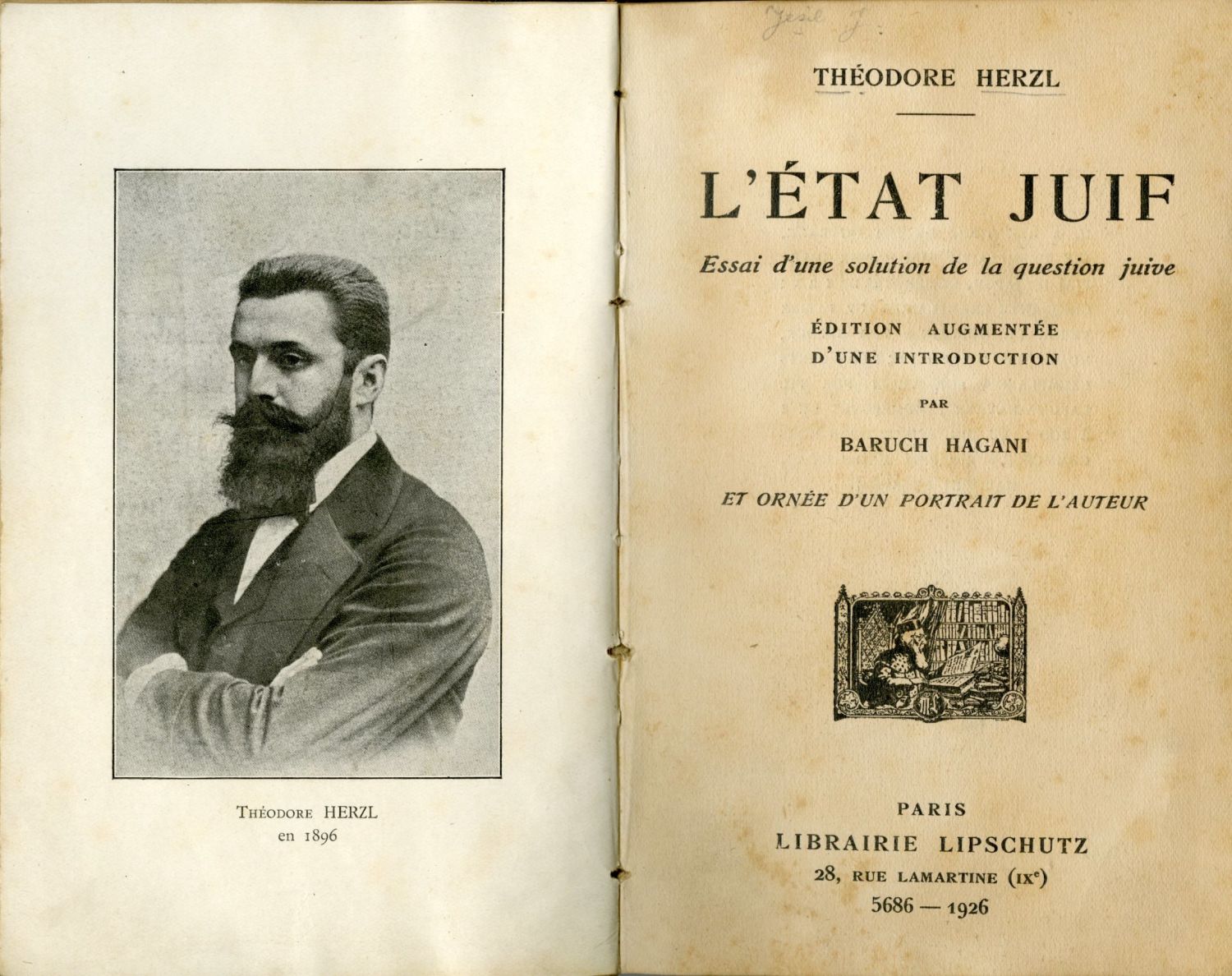
L'ETAT JUIF Essai d'une solution de la question juive - Theodor Herzl - The State of the Jews - Herzl's famous essay on the solution of the Jewish question, Paris 1926 - Rare French edition - special edition with introduction by Baruch Hagani - limited edition - copy of only 260 published. On the page next to the title page is a portrait of Theodor Herzl as photographed in 1896 (The year the book was first published).
In "Der Judenstaat", Herzl outlines his vision for the future Jewish state, in great detail. Herzl set out the structure of the future state in the days when it was considered a distant dream among most Jews. The book was first published in Vienna and Leipzig by M. Breitenstein, February 14, 1896, about a year and a half before the convening of the First Zionist Congress.
238 p. 19 cm. Good condition.
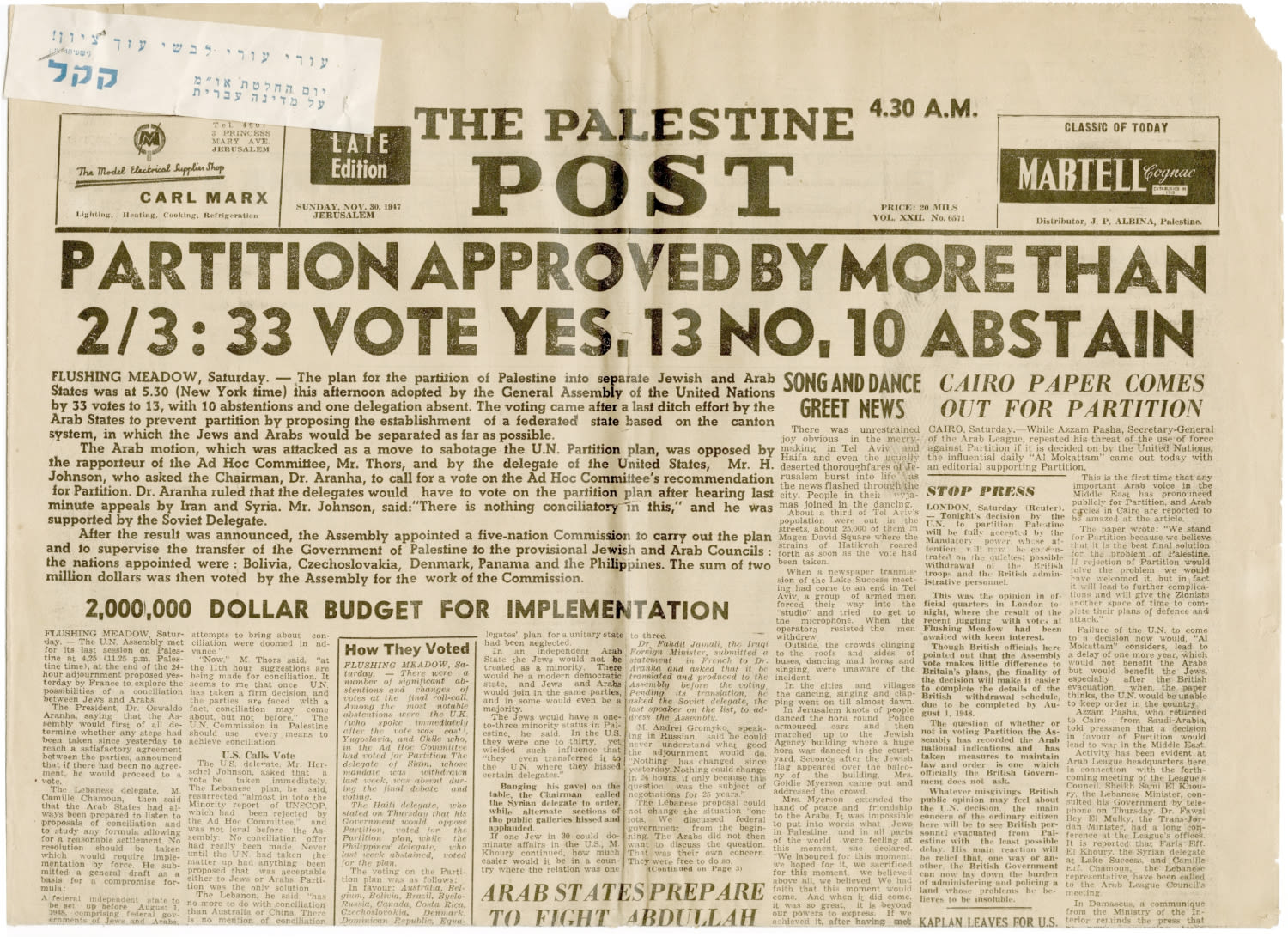
Historical issue of THE PALESTINE POST dated November 30, 1947 announcing the UN resolution establishing the Hebrew state in Israel entitled: "PARTITION APPROVED BY MORE THAN 2/3 33 VOTE YES, 13 NO, 10 ABSTAIN". The top left is fastened to the sheet the original piece of paper in which the verse from Isaiah is quoted: "עורי עורי לבשי עוז ציון" And "UN Resolution Day on the Hebrew State" JNF ".
According to the partition plan, it was proposed that a Jewish state be established, which would include the coastal plain from Ashkelon to Acre, the Eastern Galilee and a certain area south of it, as well as most of the Negev. The Arab state was supposed to include the rest, except for Jerusalem, which they proposed to become an international city under UN control. The plan was approved by the Jewish Agency and rejected outright by all Arab parties. At a UN vote on November 29, 33 countries voted in favor of the plan, 13 voted against, and 10 abstained. The decision paved the way for the end of the British Mandate, and for the establishment of the State of Israel.
4 pages. Complete sheet. Folding marks. Slight tears at margins. Good condition.

13 notebooks and pocket books containing dozens of poems, stories, notes, plays and letters - all in the handwriting of the renowned Hebrew writer and playwright Haim Hazaz. Before us is an unprecedented discovery, as the collection of essays before us has never been printed, nor published on any stage.
Some of the notebooks before us were written in the early period of Hazaz's creation [in the 1930s and 1940s], and others in a later period. For example, there are: an early notebook with dozens of short stories and plays, a song that opens with the words 'a long, strong, tanned hand', a story about 'the night watchman in the Foreign Legion', a long story 'while the glasses are paired' with dozens of corrections and erasures while writing, A notebook with Hasidic stories - Some of them in Yiddish often he quoted from Agadot Chaz'al in Jewish topics, a notebook with notes about Spanish Jewry during the Inquisition, a long story called 'Old Lapin', a song 'Kinneret', long lists of short words and sentences and their literary commentary, and many other passages and essays, which have not been thoroughly tested by us.
Haim Hazaz [1898-1973] A Hebrew writer and playwright, a man of spirit and thought, one of the most prominent of his generation and a cultural leader. Winner of the first Israel Prize for Literature. In the spring of 1931, he moved to Eretz Israel from his hometown of Kiev, and after a few months settled in Jerusalem, where he never ceased to create his extensive work in the field of literature, while standing in an unprecedented position of influence on Hebrew culture in Israel.
13 notebooks. Different sizes. Some notebook pages have moisture stains (no text damage), general condition good - moderate.
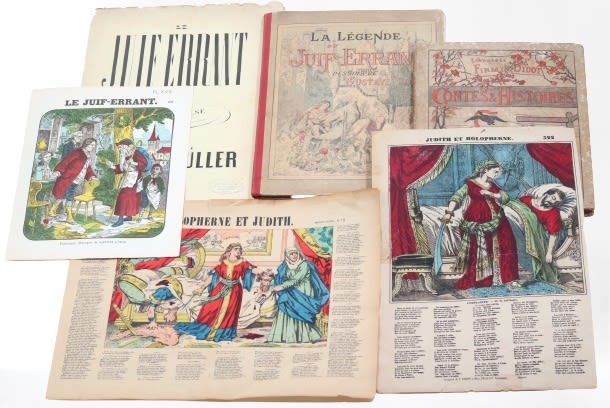
1. LA LEGENDE DU JUIF ERRANT - The Legend of the Wandering Jew with Woodcuts by Gustav Dore, Paris 19th Century. The book is accompanied by 12 large wooden engravings over an entire page depicting scenes of the wandering Jew legend, as well as musical notes to the songs of the wandering Jew. 27 pages + 12 boards. 32 cm. Some of the book pages are detached.
2. LE JUIF ERRANT - Antisemitic children's book. Paris 1883, first edition - watercolor lithographs. Contes et Histoires LES CINQ SOUS D'ISAAC LAQUEDEM LE JUIF ERRANT - Antisemitic children's book about 'The Wandering Jew' by CH. GILLOT, accompanied by watercolor lithographs, Paris 1883, first edition. [10], 142 p. 28 cm.
3-4. JUDITH ET HOLOPHERNE - Air du Juif Errant - two posters that combine the story of Judith and Holofernes in the legend of the wandering Jew of the 19th century. 1. Judith and Holofernes - a lament for the wandering Jew. Published by P. DIDION - 19th Century France. Hand-painted lithographic. 2. HOLOPHERNE ET JUDITH - Lithographic poster from the IMAGES D'EPINAL series no. 18. The two lithographs show the figure of Judith, one showing her before the beheading of Holofernes, and the other after the beheading. Accompanied by a story that combines the story of Judith with the legend of the wandering Jew - the dangerous Jew who must be warned of who is able to defeat the enemy in quick action even when his end seems to be near. 38x27 cm, and 39x30 cm.
5. JUIF ERRANT GRANDE VALSE F. BURGMULLER - Booklet of musical notes for the songs of 'The Wandering Jew'. 12 p. 36 cm.
6.
LE JUIF ERRANT - A poster in a colorful lithographic print showing the 'Wandering Jew'. 29x22 cm.
general condition good.
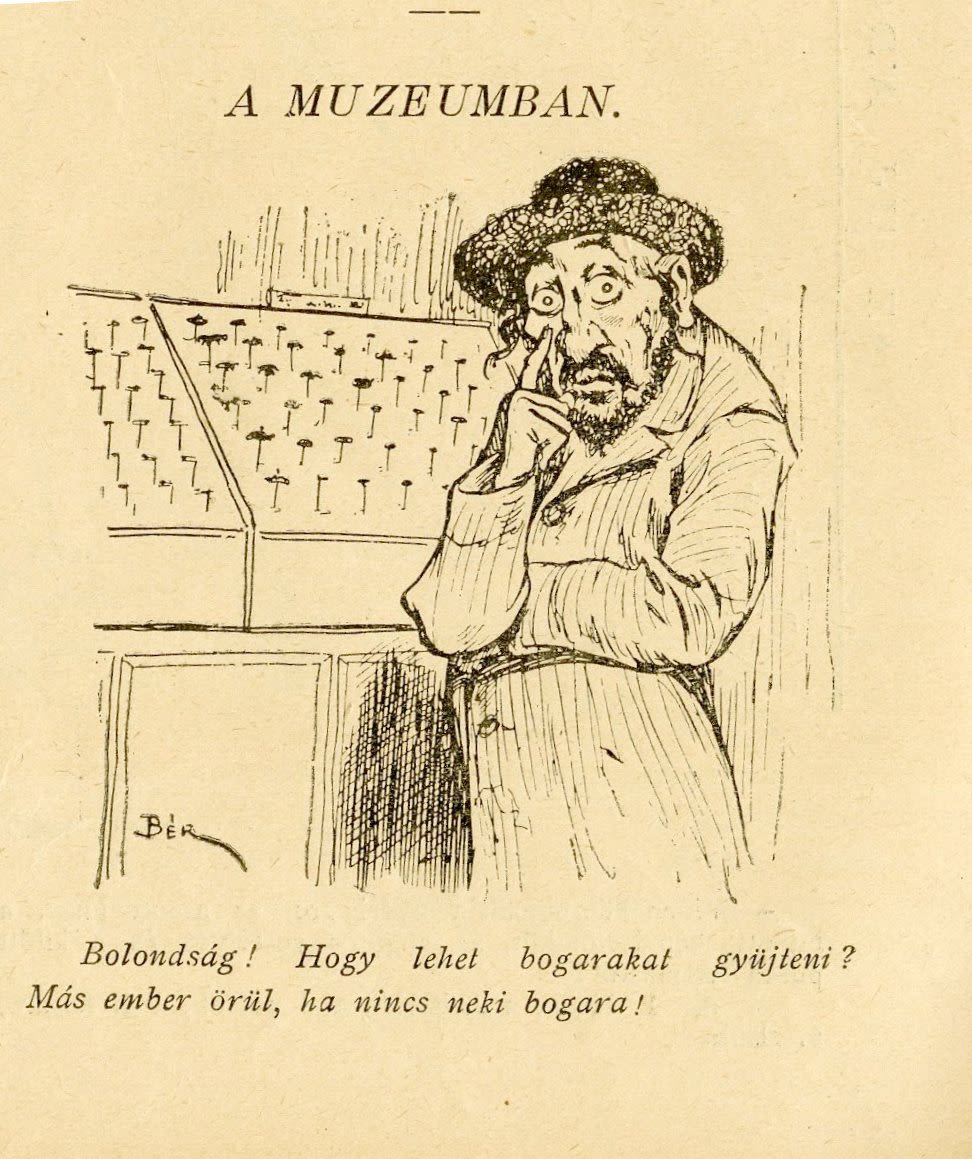
Kakas Marton - A large collection of 50 issues (Consecutive, bound) of the Hungarian antisemitic magazine "Kakas Marton". Budapest, January - December 1898. From the rarest early antisemitic publications known to us today.
The issues are accompanied by many antisemitic cartoons portraying the Jews as the enemies of Hungarian society and the kingdom.
Kakas Marton was published in Budapest once every two weeks between 1894-1914 as an annex to Hírlap. The first editor of the magazine was Victor Rakausi who published under the pseudonym Sipulusz. It was later edited by Szöllősi and then by Andre Rákosi. The reporters who wrote in it gained great popularity in Hungarian society.
The new Hungarian kingdom founded in 1867 first enacted the Emancipation Law, which gives Jews equal rights like all citizens of the country. In 1895 further progress was made and even the Jewish religion was recognized as one of the religions in the country, and gained equal status with the Catholic religion and the Protestant religion. As a result, the proportion of Jews among the leaders in economic, commercial, legal, and cultural life rose rapidly toward the end of the 19th century. While their share of the general population was about four percent, about half of the merchants, doctors and lawyers were Jews. As a result, a widespread antisemitic awakening began, led by MP Victor Ishtuzi. Against this background, the weekly before us was published. The purpose of the issues was to ridicule and highlight the differences between the Jews and the danger they pose to Hungarian society. Alongside cartoons mocking the heads of the Hungarian government, there are cartoons mocking the Jews and their overt and covert influence on Hungarian society.
Extremely rare. The magazine was not mentioned at all in "Die Juden in der Karikatur" which was published in 1921.
[53] bound sheets. Very good condition.

A rare issue of the American newspaper "The Examiner" dated September 10, 1899 announcing Dreyfus' sentence in a retrial in the Rennes Military Court in which Dreyfus was found guilty of treason and sentenced to ten years in prison. On the title page is a large photograph of Dreyfus on the right, and on the left is a painting of the prison to which Dreyfus was sent. A rare historical Documentation of an affair that shook the whole of Europe, and heard of it reached as far as the distant United States.
The title page is all about trial and vivid descriptions from the courtroom, Dreyfus himself showed no sign of reacting and maintained restraint. A demonstration in favor of Dreyfus took place outside the courtroom at the time. The headline reports that in a majority of five judges against two Dreyfus is found guilty. Below Dreyfus' picture is written: "Captain Alfred Dreyfus twice convicted of treason." The paper extensively reviews the affair from its inception and also expands on the first trial held in 1895 as well as the humiliation ceremony in which the ranks of Dreyfus were removed. At the bottom of the page is a short article stating that Dreyfus is innocent and that his sentence is a cruel act of injustice. It is important to note that only a week and a half after the date on which the newspaper before us was published, Everything changed and Dreyfus eventually got the final pardon.
10 pages. Complete sheet. 55 cm. Stains. Good condition.
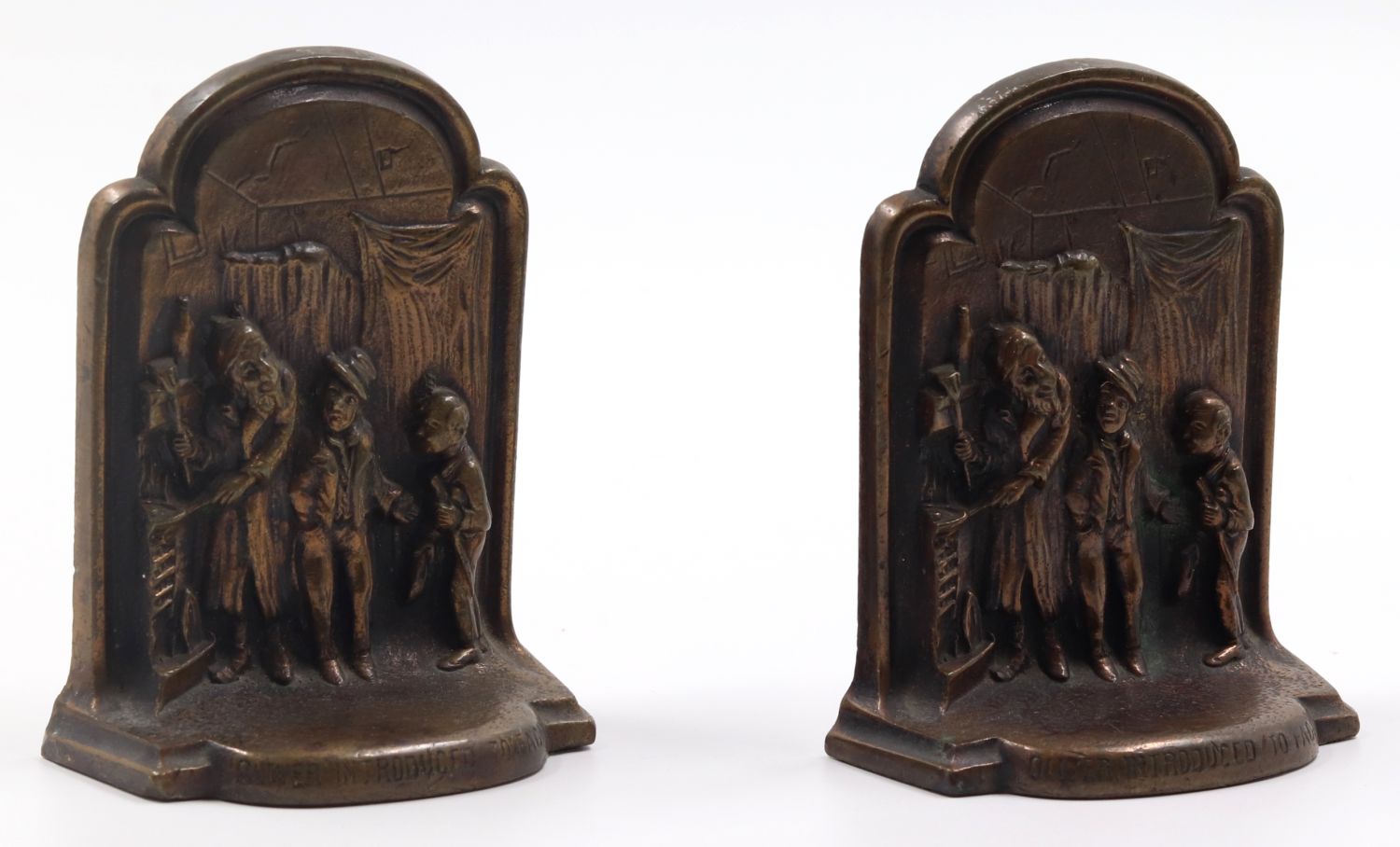
Two book holders "Oliver's introduction to fagin" - a relief work that presents the scene in which Oliver first meets Fagin the Jewish crook, from the novel 'Oliver Twist'. England, 20th century.
On the backs of the book holders the scene is described in engraved letters: "Oliver's introduction to the respectable old gentleman. this is him, fagin said the artful dodger, my friend "oliver twist". The jew grinned & took him by the hand we are very glad to see you "oliver" very, said the jew HA! HA! HA!"
The figure of FAGIN presented as a Jewish criminal and leader of a group of pickpocket children is taken from the novel 'Oliver Twist' by Charles Dickens [published in 1838], the stereotypical character appears in the book as a Jew in neglected clothing and messy hair. In the novel, FAGIN is most blatantly described as an evil villain and may be teaching children how to steal, and is often mentioned not by his first name, but by the nickname "the Jew." Although in his later years, Dickens was disturbed by the stereotypical image he created, following the sale of his house in London to the Jewish banker James David, and in later editions of the book many of the "Jewish" mentions omitted refer to the criminal FAGIN, Nevertheless, the figure was accepted throughout Europe in various forms as a typical figure for the "jewish" crook and the thief Threatening the local population.
12x9x5 cm. Very good condition.
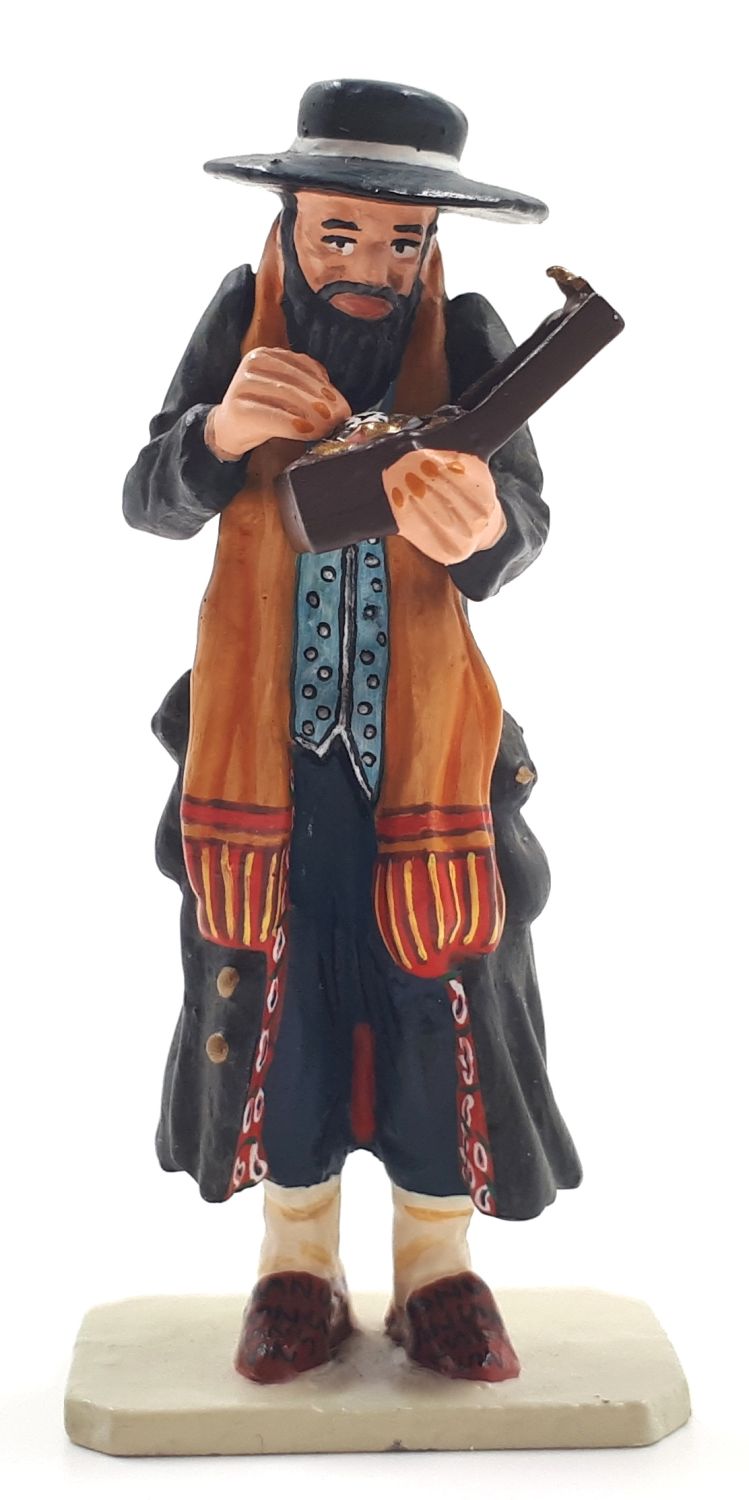
Antisemitic statue - Fagin the jew holds in his hand the jewelry box, KING & COUNTRY WORD OF DICKENS, a rare model. the 20th century.
The figure of FAGIN presented as a Jewish criminal and leader of a group of pickpocket children is taken from the novel 'Oliver Twist' by Charles Dickens [published in 1838], the stereotypical character appears in the book as a Jew in neglected clothing and messy hair. In the novel, FAGIN is most blatantly described as an evil villain and may be teaching children how to steal, and is often mentioned not by his first name, but by the nickname "the Jew." Although in his later years, Dickens was disturbed by the stereotypical image he created, following the sale of his house in London to the Jewish banker James David, and in later editions of the book many of the "Jewish" mentions omitted refer to the criminal FAGIN, Nevertheless, the figure was accepted throughout Europe in various forms as a typical figure for the "jewish" crook and the thief Threatening the local population.
Length: 7 cm. Good condition.
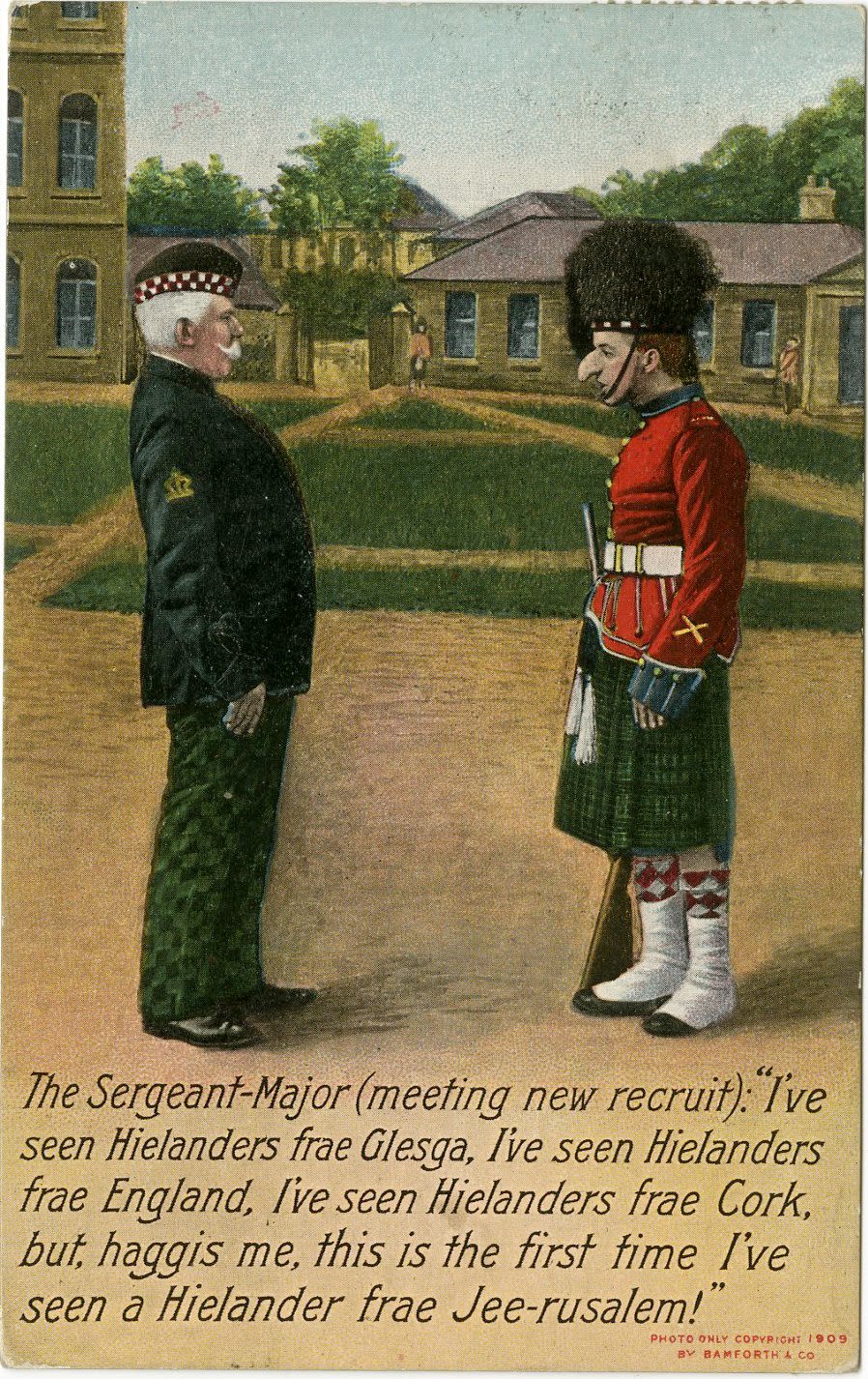
10 antisemitic postcards, Europe and the United States, early 20th century.
an antisemitic postcard showing a Major meets a Jewish soldier with a long nose for the first time and the anti-Semitic caption: 'I've seen Hielanders frae glesga, I've seen Hielanders frae england, I've seen hielanders frae cork, but, haggis me, this is first time I've seen a hielander frae jee-rusalem" - In free translation that mocks the Jew of English: "I saw soldiers from different nationalities, but this is the first time I see a soldier from Jerusalem", The greedy Jew counts the money (postcard with photochrom print), the mistress of the rich Jew, The lying Jewish antiquities dealer, CONSILIU - 'The Council' - a group of Jews gathering, the jubilant Jew: "If business comes before pleasure, cast business aside", the Jew with the long nose , And others.
Five of them were mailed, overall very good condition.
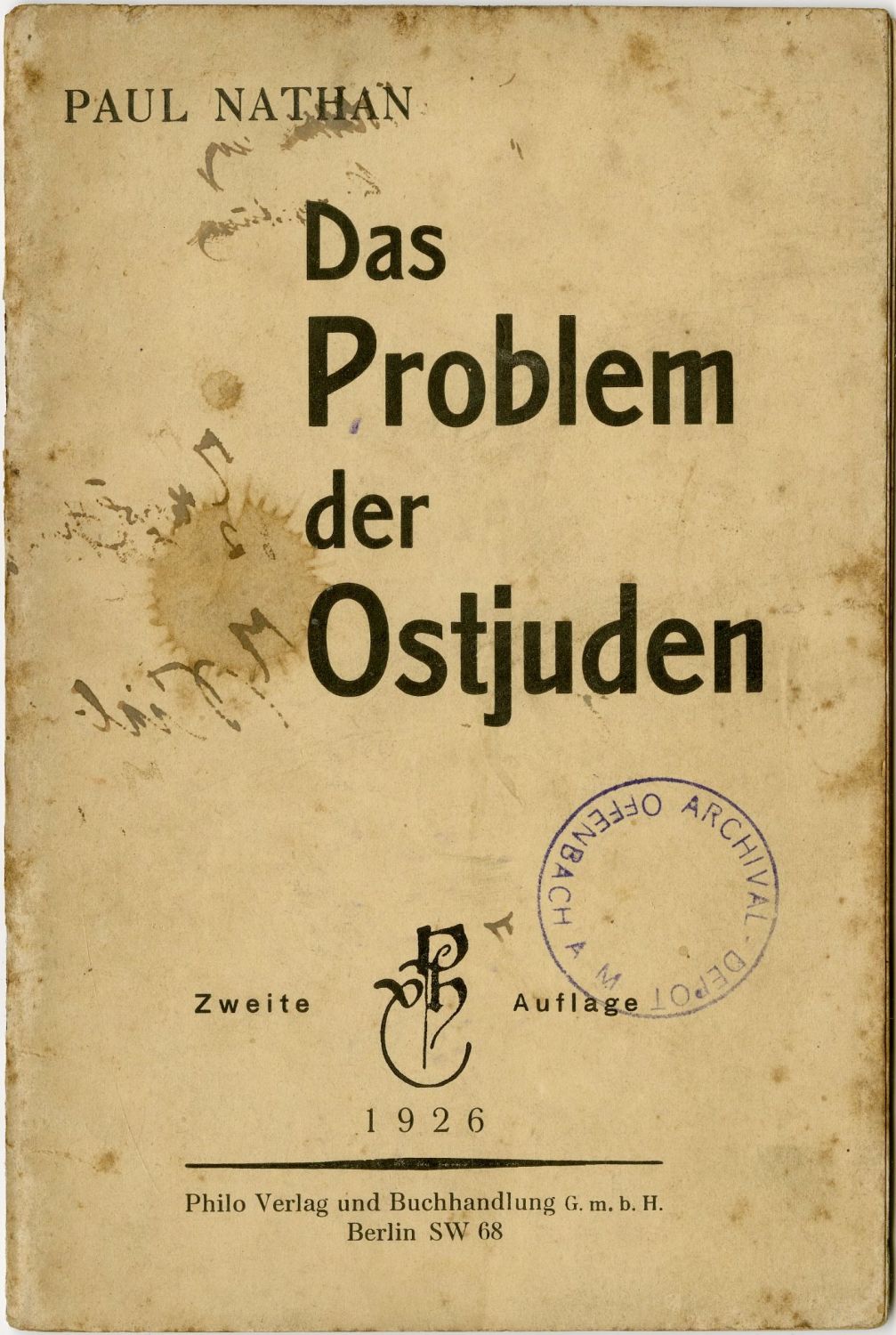
Das problem der ostjuden - The Problem of the Jews of the East, by Paul Nathan - an early attempt to arouse the Jews of Germany to take care of their fate towards the difficult future. Published by Philo Verlag und Buchhandlung Berlin, 1926. only edition.
An early attempt that is a kind of 'prophecy' to solve the 'Jewish problem' at an early stage, written by a Jew in Berlin itself. The author, Dr. Paul Natan [1857-1927], a German-Jewish journalist, politician and philanthropist, who founded and headed the German Jewish Aid Society ("Hilfsverein der Deutschen Juden") worked extensively to help the Jews of the world, especially to the Jewish community in Eretz Israel, and is one of the founders of the Technion in Haifa. In this essay he suggests that the Jews must solve the 'Jewish problem' themselves in the form of controlled immigration to the United States or to Eretz Israel, Before it will be too late. Paul clearly recognizes the pressure in which the Jews faced rising anti-Semitism in Germany. Five to six million Jews living in unbearable economic and political conditions in a relatively small area of northeastern Europe could inevitably lead to a catastrophe for the Jewish population in the future. Paul addresses the hundreds of thousands of Jews living in Germany at the time with they feeling that this is their natural home, that they will understand the reality, and that they will wake up to the seriousness of the situation, and that at least in the first instance they will emigrate to the safer Soviet region. It should be noted that at first Natan saw himself as a German and did not deal with the Jewish issue, but only within the framework of state laws and his general support for liberalism and equal rights. But when he tried to be elected to the Reichstag he was not accepted because he was jew. Out of frustration on the one hand, and concern over the rise of political anti-Semitism on the other, Nathan decided to devote himself to Jewish affairs.
38 p. 20 cm. Stains on cover. Slight tear in the corner of several pages without damaging text. condition good - moderate.
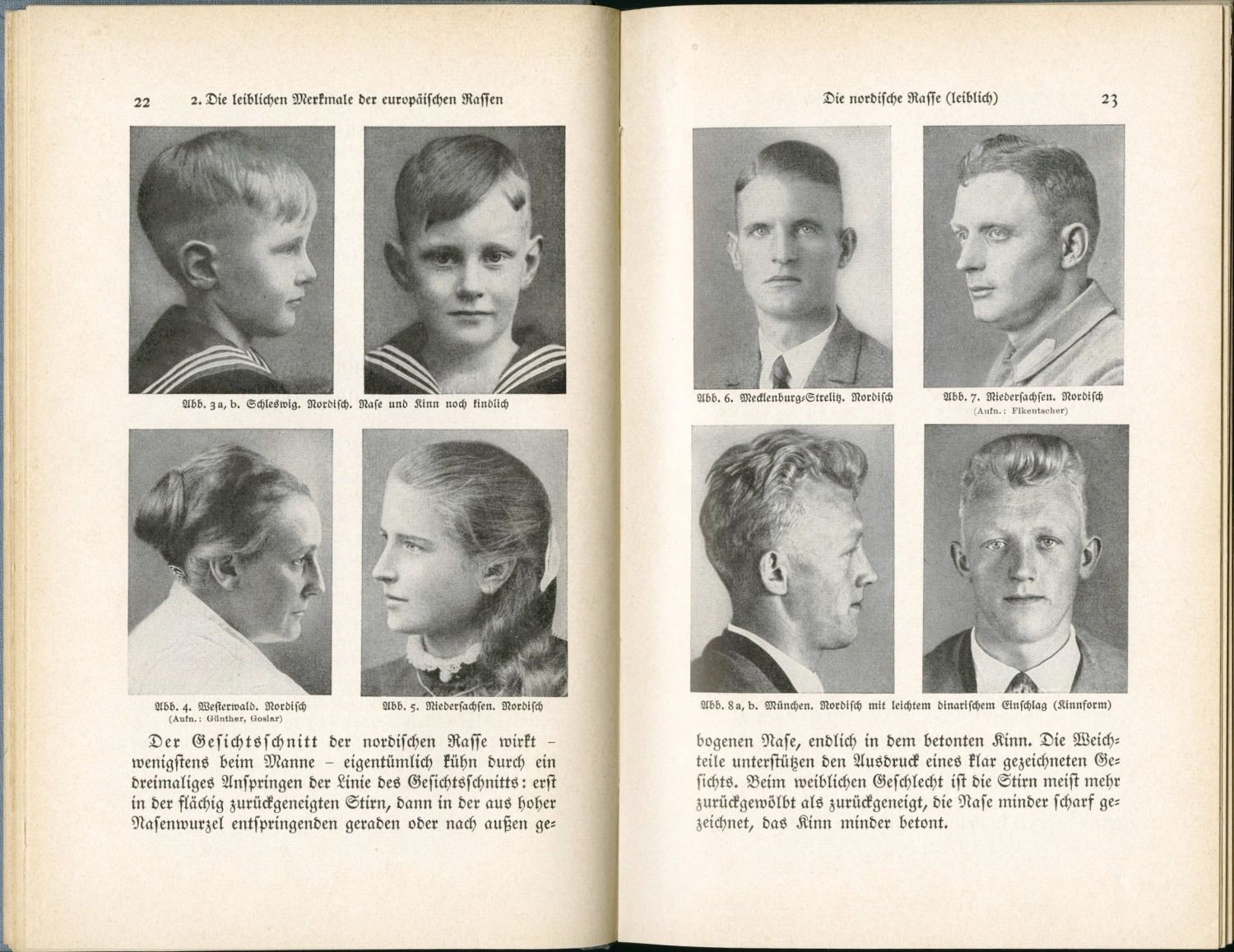
Kleine Rassenkunde des deutschen Volkes - A short ethnology of the German people by Prof. Dr. Hans Friedrich Karl Günther with one hundred illustrations and 13 maps. Published by F. lemanns, Munich 1935. Antisemitic publication in a "scientific" disguise that compares the skulls of the "inferior" races - the Jews, and others to The German: Many photographs of portraits and racist analysis of the skulls of European peoples compared to Jews.
The author [1891-1968] is considered one of the most prominent influencers of Nazi racist thought, and his theories stemmed from the prevailing Norse ideology at the time. He goes on to characterize and investigate the Jewish race in an attempt to determine its inferiority from a "scientific" point of view. In his opinion, the Ashkenazi Jew is a mixture of races from East and West, "a foreign plant that flowed from Asia into the European texture" and has different physical characteristics from those of the original Europeans. It divides the European population into six races whose chosen one is the Norse race, and calls for the unification of the Norse peoples to ensure their control, and warns against mixing them with other races. In the book many photographs of portraits of the various races, with individual reference to each organ in the face, and an attempt to "scientifically" explain the superiority of the Aryan race over the other races.
It is known that Adolf Hitler encouraged Hans' theories, and his library had four different editions of the book. In one edition, particularly prominent signs of use were found, and Hitler included his books in the list of books recommended for all Nazis to read.
Gunther joined the Nazi Party in 1932 as the only leading race theorist to join the party before coming to power in 1933. In 1935 he was declared by the party as "the pride of the National Socialist Party", and in 1940 he received the Goethe Medal for Arts and Sciences from Hitler. In March 1941 he was received as a distinguished guest at the opening conference of the "Alfred Rosenberg Institute for the Study of the Jewish Question" at which the possibility of sending Jews to labor camps was discussed. After the war he was detained and placed in detention camps for three years, but was released as it was determined that he had not incited to murder. Even after the fall of Nazi Germany, he continued to adhere to his racial theories, engaging in "state-sponsored family structure planning", and denying the Holocaust until his death.
153 [14] p. Original cover. Very good condition.
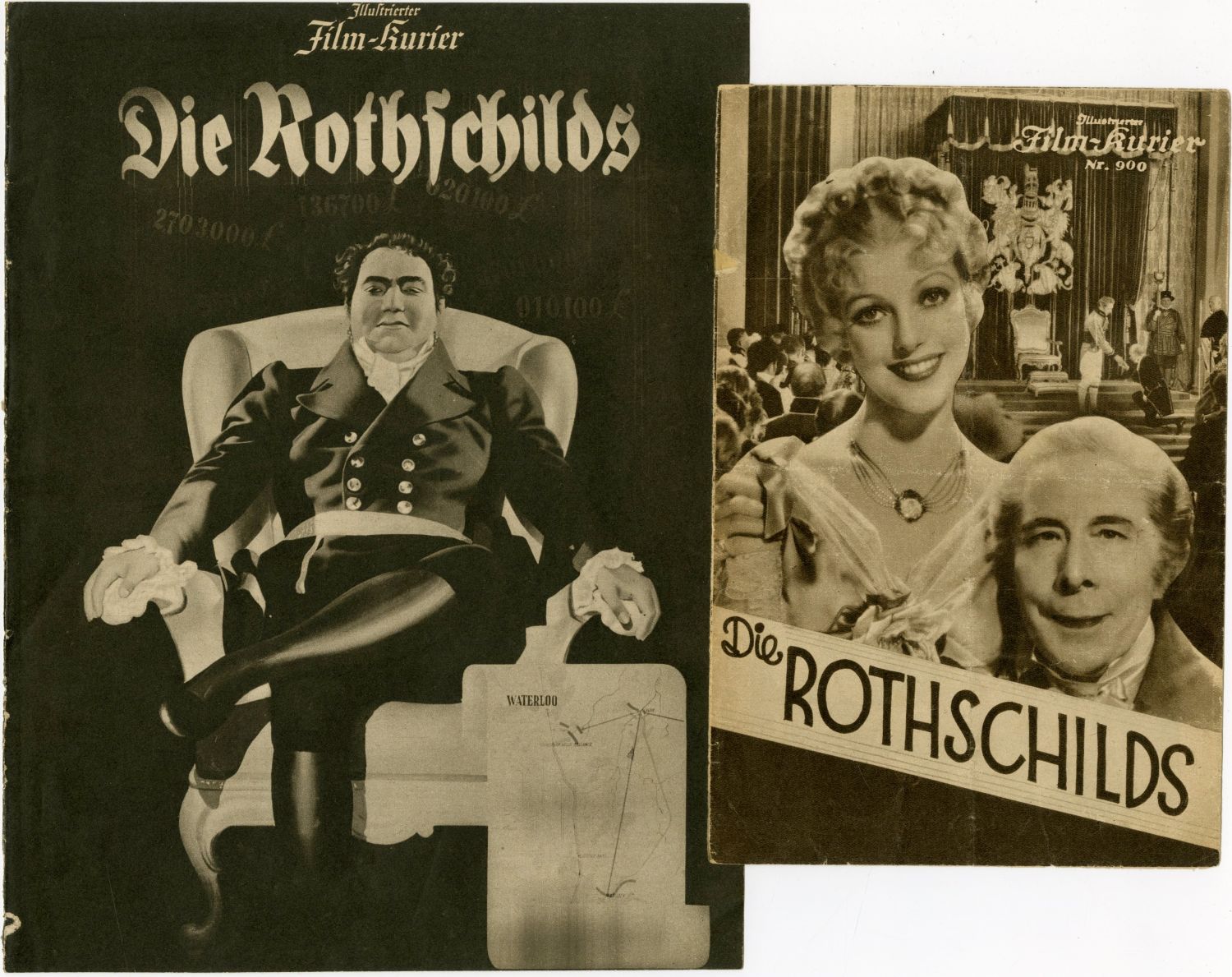
Two publications for the antisemitic feature film - "The Rothschilds" - Vienna, and Berlin, 1930s.
* Program for the antisemitic feature film "The Rothschilds" directed by Erich Waschneck. Published by "Illustrierter Film-Kurier" Berlin, [1930s]. Many photographs and texts from the film [8] pages, 30 cm. Very good condition.
* Program for the antisemitic feature film "The Rothschilds" Directed by Alfred Warker, published by "Illustrierter Film-Kurier" Vienna, [1930s]. Many photographs and texts from the film. [8] p. 23 cm. Good condition.
The antisemitic film "The Rothschilds" describes the life of the Rothschild family in the Jewish ghetto in Frankfurt until it reached positions of control in France, Germany, Austria and Britain. It was first screened in 1934 in America, and was soon used by the Nazi Party, which sought antisemitic material to screen on film. The movie "The Rothschilds" deals with antisemitic propaganda under the guise of a plot that allegedly reveals the true character of the Jews in general. In the movie, the Jews were portrayed as corrupting the world economy and trade, and as having self-interest at the expense of the countries in which they live. The film is intended to convey to the German public the message that the Jews are the greatest enemy of the economy living within them.
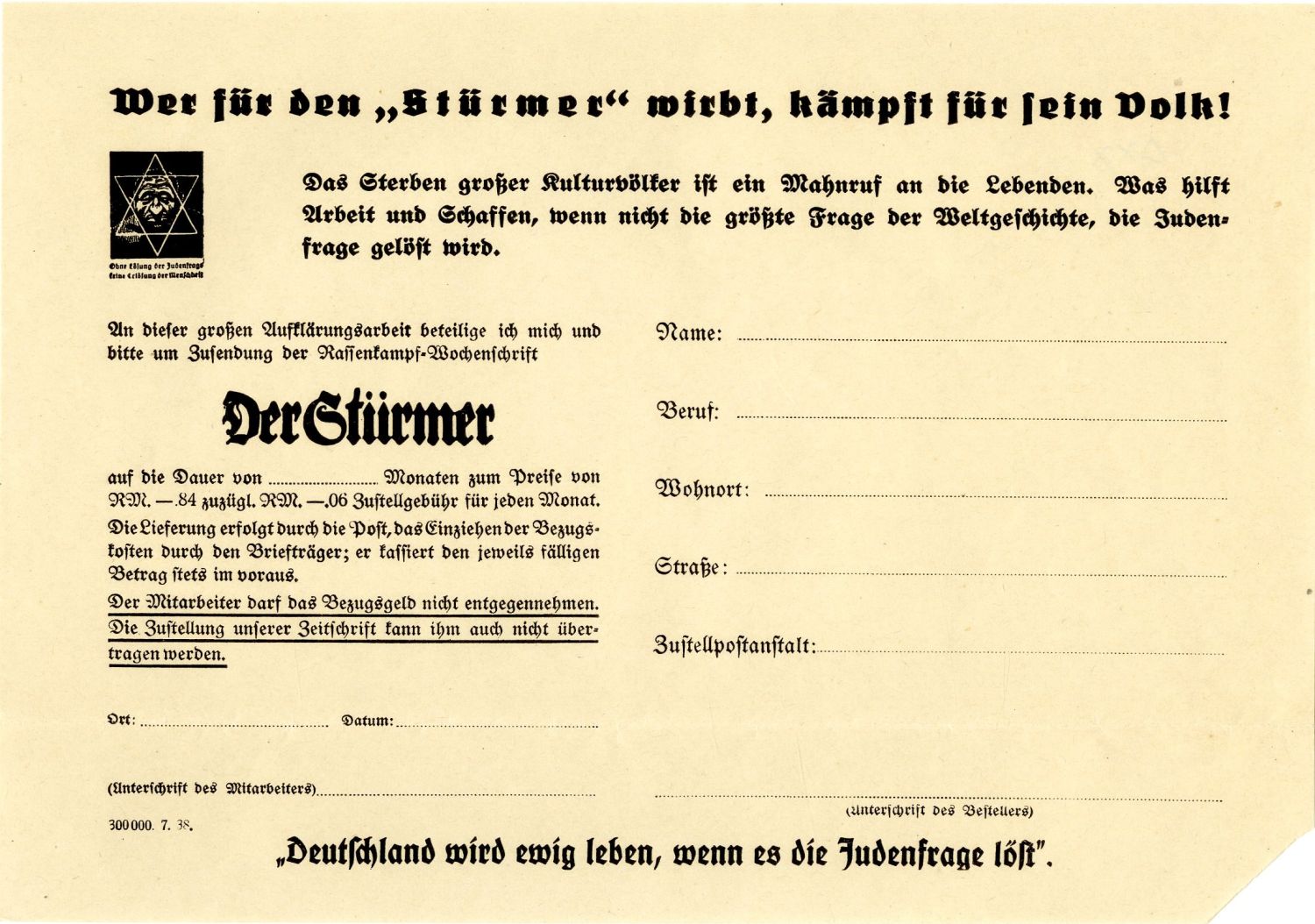
Subscription form for the antisemitic "Der Stirmer" newspaper founded by Julius Streicher - the wildest and most brutal antisemitic incitement newspaper of all time. At the top of the form is written: "Wer fur den "Sturmer" wirbt Kampft fur sein volk" (German) - "Whoever promotes the 'Stirmer' fights for his people.". Below are details about the dates of the newspaper's distribution, the method of delivery, an empty space for filling in the details of the subscriber's applicant and more. Top left is an antisemitic cartoon depicting a Jew with a stereotypical face inside a Star of David. Below is the inscription: "Deutschland wird ewig leben wenn es die Judenfrage loft "- "Germany will live forever if it solves the Jewish question".
Der Stürmer ("The Assailant") was an extremist antisemitic weekly that spearheaded Nazi propaganda in the war against the Jews. The paper was founded in the spring of 1923 by Julius Streicher, and appeared until the end of World War II in 1945. Streicher was known as a particularly extreme and cruel anti-Semite, and this is evident in the contents of his newspaper. The newspaper engaged in wild antisemitic incitement throughout its years of existence, and it is considered to this day the most radical newspaper that came out against the Jews during Nazi rule, and in general. The type of the newspaper was rude, aggressive and easy to understand. The articles consisted of simple, clear and blatant propaganda sentences, repeated anti-Semitic cartoons, antisemitic stories (which were also intended for young people - An antisemitic story appeared in each issue in sequels about the 'Jewish merchant'), and photographs of Jews in ghettos accompanied by antisemitic hate speech. As part of the newspaper's aggressive antisemitic line, he adopted as his motto the saying invented by Heinrich Treichka - "Jews are our disaster!" (In German: "Die Juden sind unser Unglück"). This slogan was engraved on the bottom of the title page of every issue since 1927, and was also used by the Nazis at official conferences. The peak circulation of the newspaper reached about eight hundred thousand copies.
21x15 cm. Slight tear in the bottom right corner. Good condition.
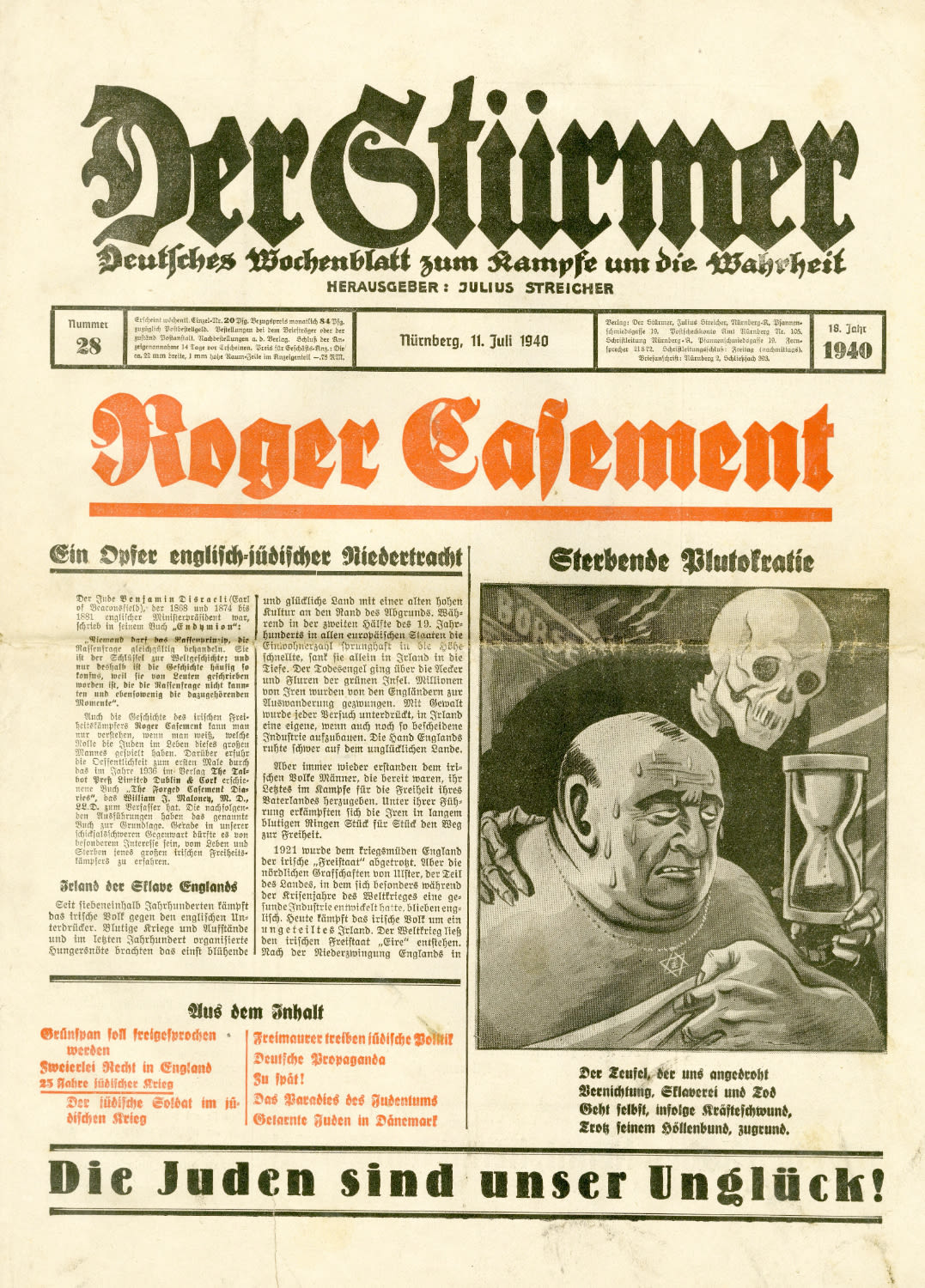
2 issues of the antisemitic weekly 'Der Stürmer' founded by Julius Streicher - The wildest and most brutal antisemitic incitement newspaper of all time.
* Issue No. 1 dated: January 16, 1938. The headline of the newspaper 'Madagascar', and a large cartoon of a Jew embracing the earth with his hands, and an antisemitic caption: "The crisis angers the Jew, the new side arouses nerves in him ... He's afraid the end is near ... ", And an antisemitic article emphasizing the Gestapo's role in the persecution of the Jews as something that was finally done after years of neglecting treatment the "Jewish problem." The paper is full of articles and harsh antisemitic cartoons. Tears in margins of some pages. Stains. Detached pages.
* Issue No. 28 dated: July 11, 1940. On the title page of the newspaper is an antisemitic cartoon in which the devil is seen embracing a Jew with an hourglass in his hand and the antisemitic caption about the devil threatening through the Jew. And a long article about the 'angel of death' in the form of the Jew. On one of the middle pages is a photograph of a Jew in Vienna during a Tvilah in the mikveh and the antisemitic caption that accompanies the photograph: "here, the Jews mumble prayers and wrapped up in. The water gets a black-gray color within a few hours from the smell of the jews." And many antisemitic articles and pictures. (On page 9 a missing tear on the left at the top of the page with text impact on several lines).
Der Stürmer ("The Assailant") was an extremist antisemitic weekly that spearheaded Nazi propaganda in the war against the Jews. The paper was founded in the spring of 1923 by Julius Streicher, and appeared until the end of World War II in 1945. Streicher was known as a particularly extreme and cruel anti-Semite, and this is evident in the contents of his newspaper. The newspaper engaged in wild antisemitic incitement throughout its years of existence, and it is considered to this day the most radical newspaper that came out against the Jews during Nazi rule, and in general. The type of the newspaper was rude, aggressive and easy to understand. The articles consisted of simple, clear and blatant propaganda sentences, repeated anti-Semitic cartoons, antisemitic stories (which were also intended for young people - An antisemitic story appeared in each issue in sequels about the 'Jewish merchant'), and photographs of Jews in ghettos accompanied by antisemitic hate speech. As part of the newspaper's aggressive antisemitic line, he adopted as his motto the saying invented by Heinrich Treichka - "Jews are our disaster!" (In German: "Die Juden sind unser Unglück"). This slogan was engraved on the bottom of the title page of every issue since 1927, and was also used by the Nazis at official conferences. The peak circulation of the newspaper reached about eight hundred thousand copies.
Two complete sheets. moderate condition.
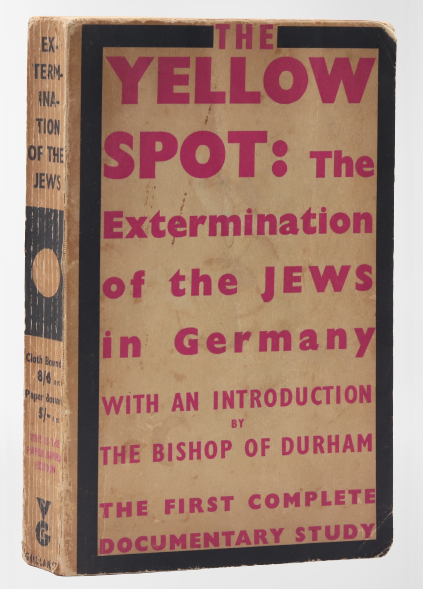
THE YELLOW SPOT: The Extermination of the jews in Germany with an introduction by the bishop of Durham, - THE FIRST COMPLETE DOCUMENTARY STUDY - Published by VICTOR GOLLANCZ LTD, London 1936 - First Edition. The first ever exposure of Nazi Germany's antisemitic propaganda machine against the Jews in all areas of life. The book reports on the forms of anti-Semitism as expressed at the time of publication, and relies on dozens of sources: the Nazi press itself, the German schools and education, and the official institutions in Germany - many photographs and documents that first appeared in the publication before us revealing "The situation of the Jew in Germany currently".
Brave and early publicity of its kind examining The difficult situation of German Jews in all areas of life under the influence of Nazi racism, before the deportation of the Jews to the death camps and the terrible Holocaust. Exposure of severe antisemitic Public phenomena that at that time were not known to the wider world such as: Deportation of Jews from businesses in German medicine, law, and culture. Forced sale of Jewish businesses, denial of Jewish civil rights in Germany, including a ban on immigration, closure of public places of entertainment for Jews - such as swimming pools, museums and theaters, Definition of villages and areas "forbidden for Jews to enter", Discrimination against Jewish patients in hospitals. An important part of the book deals with the phenomenon of Studying 'race theory' in German primary schools accompanied by antisemitic education, and exposing the propaganda of the Nazi 'Der Sturmer' while quoting from the newspaper and photographs that appear in it. Quotes are provided from Nazi party leaders regarding their intentions toward the Jews, examples of 'public punishment' for humiliating Jews in Germany, as well as official punishment against "Jewish-loving" Germans, and more.
We will emphasize that the book was published in 1936 and it reveals for the first time "one of the most amazing chapters in modern history" as the editor puts it. Many such publications were published at the end of and after World War II after realizing the magnitude of the catastrophe that the theory of race had inflicted on the Jewish people. It is rare to find a publication that even in those days knew how to accurately diagnose the destructiveness of racial theory, its actual use, and the dire consequences it had on the Jews, even in those days.
287 p. 22 cm. Few stains. Good condition.

Deutsche Kunst und entartete "Kunst". Kunstwerk und Zerrbild als Spiegel der Weltanschauung, herausgegeben - German art and degenerate "art". Distorted works of art and images as a mirror of the worldview, edited by Dr. Adolf Dressler. Munich, 1938. An antisemitic propaganda pamphlet which accompanied the exhibition entartete "Kunst" - 'Degenerate Art'.
In the preface to the pamphlet, Dressler expresses more than anything the following antisemitic worldview expressed in the exhibition and in the accompanying pamphlet: "At the same time as the resurrection of the German people, we are experiencing the revival of German art. The two cannot be separated, as art is the living part of the people and the true reflection of its inner life, in the pre-war period German art began to detach from the people. Art can not live without a living connection with the people ... only when the Fuhrer, in parallel with the takeover of political power, began to reshape the entire basis of life of the German people through the National Socialist worldview, a tremendous change in German art also began. Adolf Hitler argued again the eternal appreciation of real art ... Thus began a new era for German artistic creativity, paving the way for artists to act out of an inner conviction, which is no longer subject to criticism by a Jewish-Bolshevik literary clique ... "
The booklet included photographs from the exhibition by artists such as Otto Dix, George Gross, Ferdinand Spiegel, Walter Hawk, Herman Taubert, Adolf Ziegler, Schmidt-Rotloff, Paul Roloff, Oscar Kokushka, Thomas Baumgartner, Max Beckman, and many more. When the works are displayed opposite each other on the corresponding page - a German work versus a 'degenerate Jewish work' accompanied by antisemitic sentences in the style "against each other", such as: "Plastic of the liberal age. Degenerate as the painting was the sculpture. Only distorted idiots were presented to the people as "works of art on the front, " or "At all times, the praise of the homeland was one of the most beautiful tasks of the creative artist. But what is the meaning of the German landscape to the Jewish desert people and its distorted followers?" Etc.
The antisemitic exhibition Entartete "Kunst" ["Degenerate Art"], initiated and run by the German Reich Propaganda Office, opened in Munich in July 1937 and featured some 650 works by about 100 famous artists confiscated from museums and galleries throughout Germany [including Chagall, Monk, Matisse, and Kandinsky] in order to put them to ridicule in the eyes of the public. At the same time about 20,000 works of art found in public museums in Germany were sold or destroyed. The works were hung in the exhibition rooms in a chaotic crowded manner, and were accompanied by text labels that ridicule the art.
The purpose of the exhibition was to show the public the 'decay of civilization' through original works of the human race, in the face of the great turning point in German works striving for a clean and progressive future. The Nazis called this art an "insult to German feelings." Degenerate art was defined as non-German, Jewish, or communist art in its character. The exhibition is designed to present everything that the Nazis perceived as corrupt, degenerate and perverted in modern art.
The exhibition traveled to several cities in Germany until 1941. It was accompanied by propaganda materials such as pamphlets, postcards and posters which created the antisemitic atmosphere within the framework of Nazi propaganda. Culturally, the exhibition was the culmination of the presentation of the Nazi 'enlightenment' and 'progress' in the face of the Jewish 'decay' that threatens to destroy the world in the field of art as well. The entry to the exhibition was free and was visited by over two million people during the years of its presentation. During the exhibition avant-garde German artists were now classified as enemies of the state and a threat to German culture. Many went into exile, others continued to live in Germany, but were banned from teaching at universities and the Gestapo would make surprise visits to them to make sure they were not engaged in art. Jewish artists who did not flee were sent to the extermination camps.
80 pages [32 pages of text and 47 pages of images], 21 cm. Few stains on cover. Good condition.

A rare entrance ticket to the exhibition "deutschland" - "Germany" No. 040736, which took place as part of the Berlin Olympics. July 18 - August 16 on the street next to the Berlin Olympic Stadium.
The ticket is divided into three parts: on the left "The ticket entitles you to a one-time visit to the Berlin exhibition 1936 "Germany"July 18 to August 16. The exhibition halls in Kizerdam are open daily from 9:00 to 20:00 ... The ticket will expire at the exit of the exhibition grounds." In the middle of the card is an entry permit for the football match that took place on August 10 as part of the Berlin Olympics. On the left, an unused lunch voucher. On the back of the card is a map showing the way to the "deutschland" exhibition that was shown not far from the stadium where the Olympics were held. The card itself is extremely rare, and especially with the unused lunch voucher, which we have not seen another example of.
The exhibition "Germany", which was presented at the initiative of the Nazi propaganda ministry, is intended to glorify the Nordic race, and to emphasize its superiority over other races, as well as the cultural superiority of Germany, as expressed in the film "Olympia" produced by German director Lenny Riefenstahl.
25x11 cm. Very good condition.

Issue of the antisemitic magazine 'La Difesa della Razza' - 'Race Defense'. May 20, 1939 - Many distortions of Jewish sources in an attempt to present the 'true Jew' who poses a threat to the countries of the world, And articles in race theory.
On the top of the cover of the issue the antisemitic inscription was written : "Be human and not stupid sheep, so that the Jew among you, will not laugh" (Quote that appeared regularly on the cover of the issues). The title page of the issue is an antique-style picture of horsemen on horses and the author quoted from Jewish sources as "In the destruction of Rome immediately our redemption". The main article describes a 'first exposure' of quotations that appear in the Talmud and are directed against the nations of the world in general and against the Italian nation in particular, alongside images of Jews with an Oriental orientation. The author sharply antisemitically analyzes the behavior of the Jewish nation for 1900 years. The Jews arrive as refugees in a foreign country, create a 'country within a country', take over the country they entered and soon disappear from history - this is what happened to the Babylonian Empire, the Russian Empire and more. The Jews then move on to take over another country. This behavior was characterized, according to the author, by ancient Jewish sources, from which he often quotes passages condemning the nations of the world. Then there is an antisemitic article about a 'Jewish army' being built in the United States and threatening its enemies, another article quoting a distortion from Jewish sources as if they see the non-Jewish woman as an inferior animal from a dog accompanied by harsh antisemitic images, a racist article characterizing The real Italian to the fake Italian - the Jew, and deals with the sources of the Jewish race. There is also an antisemitic article about the arrival of the Jews in Italy - this article also contains distorted quotations from Jewish sources, another article deals with condemnation of Jewish art and artists, and more.
The La Difesa della Razza [Race Defense] an Italian bi-weekly published between August 1938 and June 1943, by Telesio Interlandi, published by Tumminelli in Rome (5 years in which a total of 117 issues were published), initiated by Benito Mussolini who believed in the scripture to assimilate antisemitic ideas And racism among the Italian population.The sheets constituted the main antisemitic tool of the fascist regime, designed to promote fascist racial laws in Italy.The aim was to spread a "scientific" doctrine of racial theory, and to convince Italians that colonialism, bans on intermarriage and intermarriage Anchored in the laws of nature.The magazine presented baseless ideas in support of the superiority of the Aryan race to which the Italians claimed the Italians should belong, and warned of the 'biological contamination' that might occur if the Italians mixed with the 'inferior races'. In the 'scientific' sections of the magazine, racism and anti-Semitism gained legitimacy from a medical and biological point of view, with a focus on presenting false 'genetics' theories. The magazine even deals a lot with demography in an attempt to present statistical forecasts showing the “non-Aryan” races in constant decline compared to the Aryan races. The deeper Italy went into war with the participation of the Axis powers, the more the issue officer in antisemitic propaganda, blaming the Jews for the war, and warning of the "risks" of mixing with the Jews, which could lead to "social pollution."
48 pages, 30 cm. general condition good.
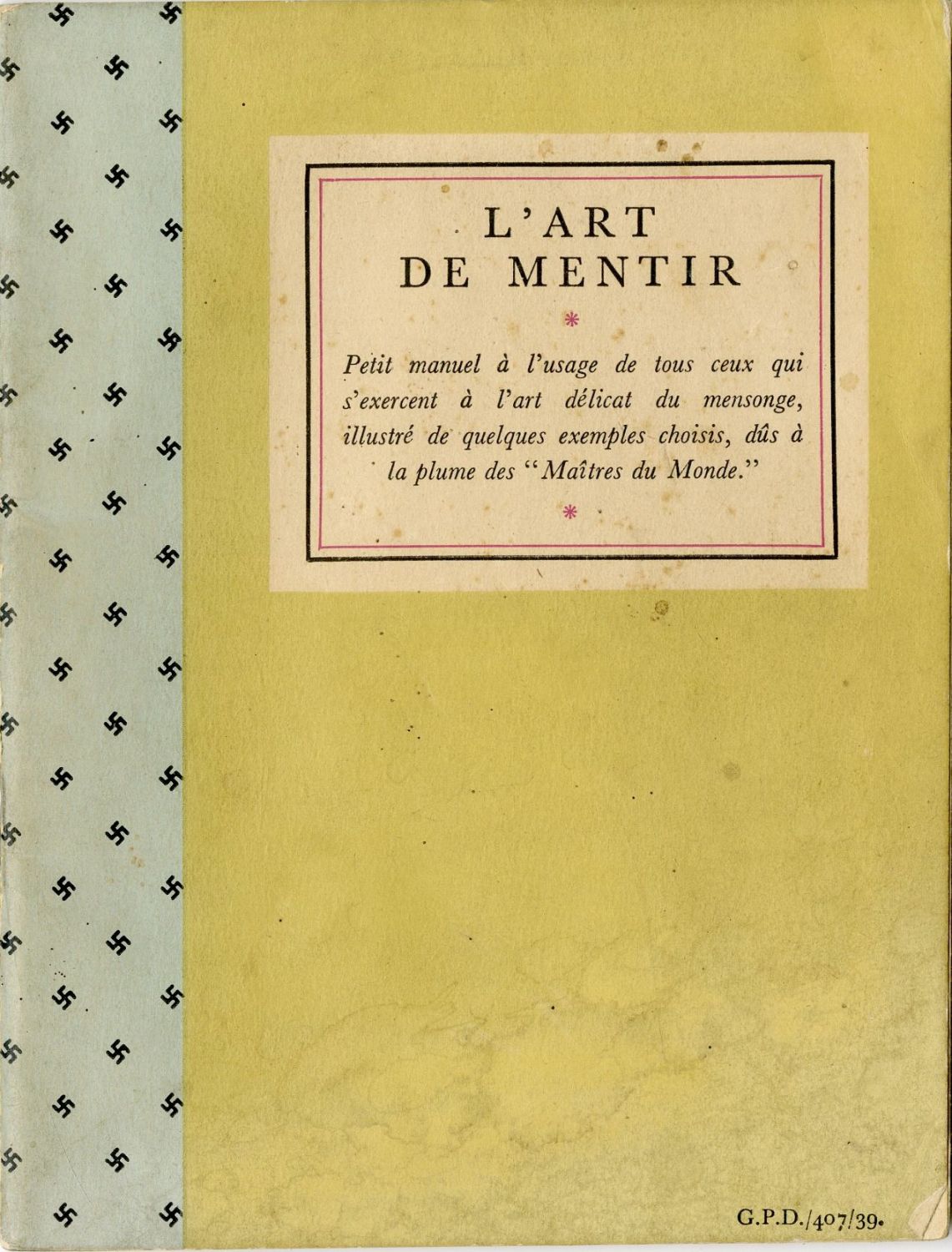
L'ART DE MENTIR - The Art of Lying - A small guide for use by all practitioners of the delicate art of lying, illustrated with a few selected examples from the "Masters of the World" Adolf Hitler and Joseph Goebbels, published by the Anglo-American Advertising and Information Bureau. French. Anti-Nazi publication of the Allies [1944].
The booklet quotes from the declarations made by Hitler and Goebbels on various occasions, regarding their military intentions towards European countries and exposing their lies one by one. The quote appears in black letters, and exposing the lie in red letters. Alongside the lies are cartoons mocking Hitler in color. For example, the pamphlet opens with a quote from Hitler's lie in May 1935: "It is in no way part of Germany's intention to interfere in Austria's internal affairs, annex it or carry out annexation" - and the well-known fact that in March 1938 Hitler invaded Austria, etc. The edges of the cover are shaped in swastikas in the guise of a booklet issued by the Nazis themselves in order to reach German hands.
35 p. 16 cm. Very good condition.
Created and Develop with 🤍By webe ©2024